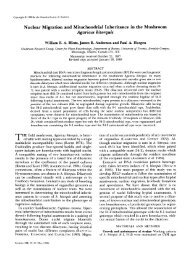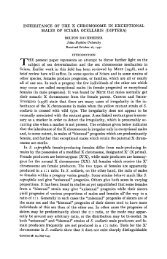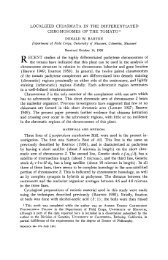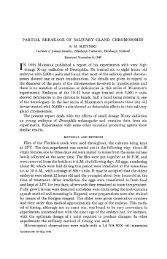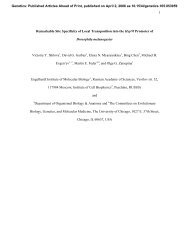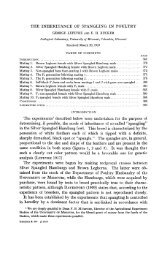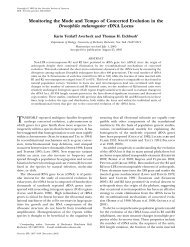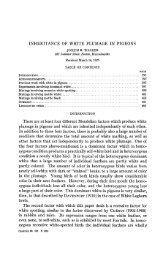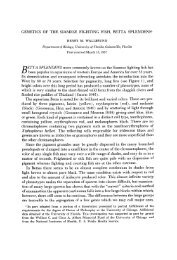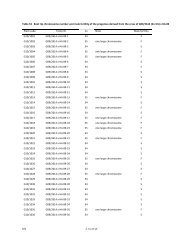abstracts of papers presented at the 1962 meetings - Genetics
abstracts of papers presented at the 1962 meetings - Genetics
abstracts of papers presented at the 1962 meetings - Genetics
You also want an ePaper? Increase the reach of your titles
YUMPU automatically turns print PDFs into web optimized ePapers that Google loves.
ABSTRACTS 973<br />
hours to several weeks, and th<strong>at</strong> this lag is dependent on <strong>the</strong> particular pair <strong>of</strong> allelic mutants<br />
combined. Fur<strong>the</strong>rmore, <strong>the</strong> r<strong>at</strong>e <strong>of</strong> growth <strong>of</strong> <strong>the</strong>se heterokaryons is also dependent upon <strong>the</strong><br />
particular combin<strong>at</strong>ion <strong>of</strong> mutants and is not strictly correl<strong>at</strong>ed with <strong>the</strong> lag time. Various ex-<br />
perimental conditions have been studied th<strong>at</strong> have no effect on <strong>the</strong> individual mutants but which<br />
alter ei<strong>the</strong>r <strong>the</strong> time <strong>of</strong> heterokaryon form<strong>at</strong>ion or <strong>the</strong> subsequent r<strong>at</strong>e <strong>of</strong> growth or both. For<br />
instance, supplement<strong>at</strong>ion <strong>of</strong> <strong>the</strong> minimal medium with both 0.1 mg/liter adenine and 200<br />
mg/liter casamino acids brings about a fourfold to fivefold reduction in <strong>the</strong> lag times found in<br />
most heterokaryon tests with unsupplemented minimal medium. The effect <strong>of</strong> <strong>the</strong> D- and L-forms<br />
<strong>of</strong> various amino acids has also been studied on 26 different combin<strong>at</strong>ions <strong>of</strong> ten complementing<br />
ad-3B mutants. Whereas <strong>the</strong> effect <strong>of</strong> D-cysteine was aspecific and resulted in a pronounced re-<br />
duction in <strong>the</strong> lag time <strong>of</strong> all combin<strong>at</strong>ions, <strong>the</strong> effect <strong>of</strong> o<strong>the</strong>r amino acids (inhibition or stimu-<br />
l<strong>at</strong>ion) on <strong>the</strong> lag time and growth r<strong>at</strong>e was heterokaryon-specific and not limited to <strong>the</strong> L-forms<br />
alone. Almost all possible rel<strong>at</strong>ionships between <strong>the</strong> D- and L-forms on <strong>the</strong> lag time and growth<br />
r<strong>at</strong>e have been found. The significance <strong>of</strong> <strong>the</strong>se findings in <strong>the</strong> term <strong>of</strong> <strong>the</strong> mechanism <strong>of</strong> allelic<br />
complement<strong>at</strong>ion will be discussed. It appears, however, th<strong>at</strong> allelic complement<strong>at</strong>ion is a complex<br />
phenomenon with <strong>at</strong> least two separ<strong>at</strong>e and independent phases. (1 Permanent address: Istituto<br />
Superiore di Sanita, Rome, Italy.)<br />
NAYLOR, ALFRED F., McGill University, Montreal, P.Q., Canada: A new rigorously-proven<br />
<strong>the</strong>orem on m<strong>at</strong>ing systems.-All <strong>of</strong> several actually known or hypo<strong>the</strong>tical m<strong>at</strong>ing systems <strong>of</strong><br />
<strong>the</strong> neg<strong>at</strong>ive assort<strong>at</strong>ive type have ei<strong>the</strong>r <strong>of</strong> two fe<strong>at</strong>ures: (1) a characteristic equilibrium allelic<br />
frequency which is independent <strong>of</strong> initial frequency; or, (2) special conditions which make <strong>the</strong><br />
actual mechanism <strong>of</strong> <strong>the</strong> “system” dependent on <strong>the</strong> gene frequency which is to be maintained<br />
while heterozygosity increases in <strong>the</strong> popul<strong>at</strong>ion. This remark is extended to a <strong>the</strong>orem, which,<br />
while not momentous, is biologically novel in th<strong>at</strong> it is an absolutely provable generality. An intuitive<br />
interpret<strong>at</strong>ion will accompany <strong>the</strong> elementary pro<strong>of</strong>.<br />
NORBY, D. E., H. C. THULINE, and J. H. PRIEST, Rainier School, Buckley, Washington: X<br />
chromosome differenti<strong>at</strong>ion in rel<strong>at</strong>ion to co<strong>at</strong> p<strong>at</strong>terns in c<strong>at</strong>s.-Applic<strong>at</strong>ion <strong>of</strong> LYON’S hypo<strong>the</strong>sis<br />
<strong>of</strong> differential sex chromosome inactiv<strong>at</strong>ion to <strong>the</strong> expression <strong>of</strong> <strong>the</strong> genes producing black and<br />
yellow mosaic co<strong>at</strong> color in female c<strong>at</strong>s depends upon establishment <strong>of</strong> <strong>the</strong>ir sex linked p<strong>at</strong>tern <strong>of</strong><br />
inheritance. The demonstr<strong>at</strong>ion <strong>of</strong> an extra chromosome in males with <strong>the</strong>se colors overcomes<br />
many <strong>of</strong> <strong>the</strong> past obstacles to <strong>the</strong> acceptance <strong>of</strong> such a p<strong>at</strong>tern.-The expression <strong>of</strong> <strong>the</strong>se alleles<br />
appears to be influenced by <strong>the</strong> autosomal gene which controls <strong>the</strong> presence <strong>of</strong> white spotting.<br />
In <strong>the</strong> presence <strong>of</strong> <strong>the</strong> spotting gene <strong>the</strong> colored p<strong>at</strong>ches are large; if its recessive allele (solid<br />
color) is homozygous <strong>the</strong> p<strong>at</strong>ches are very small. Assuming th<strong>at</strong> inactiv<strong>at</strong>ion <strong>of</strong> one <strong>of</strong> <strong>the</strong> two<br />
X chromosomes is responsible for <strong>the</strong> mosaicism, <strong>the</strong> size <strong>of</strong> <strong>the</strong> p<strong>at</strong>ch will be rel<strong>at</strong>ed ei<strong>the</strong>r to <strong>the</strong><br />
time <strong>of</strong> inactiv<strong>at</strong>ion during embryogenesis or to <strong>the</strong> specific<strong>at</strong>ion ,<strong>of</strong> <strong>the</strong> chromosome inactiv<strong>at</strong>ed<br />
in <strong>the</strong> cells <strong>of</strong> a given p<strong>at</strong>ch. Thus, <strong>the</strong> postul<strong>at</strong>ed X chromosome inactiv<strong>at</strong>ion would be under<br />
autosomal control in one or <strong>the</strong> o<strong>the</strong>r <strong>of</strong> <strong>the</strong>se two aspects.<br />
NUFFER, M. G., University <strong>of</strong> Missouri, Columbia, MO.: Consider<strong>at</strong>ion <strong>of</strong> <strong>the</strong> suppressor ele-<br />
ment hypo<strong>the</strong>sis for mutable loci.-The generally accepted hypo<strong>the</strong>sis for induction <strong>of</strong> muta-<br />
bility <strong>at</strong> a particular locus by <strong>the</strong> two unit mut<strong>at</strong>or systems found in corn is th<strong>at</strong> an undefined<br />
element moves to a gene site (A, for example) under <strong>the</strong> influence <strong>of</strong> a second element (Dt) and<br />
while <strong>the</strong>re suppresses <strong>the</strong> action <strong>of</strong> <strong>the</strong> gene so th<strong>at</strong> it expresses a recessive phenotype (a). This<br />
phenotype continues until <strong>the</strong> element moves away <strong>at</strong> which time normal gene function is re-<br />
stored producing sectors <strong>of</strong> A like tissue, hence <strong>the</strong> design<strong>at</strong>ion p. In <strong>the</strong> absence <strong>of</strong> Dt, am is<br />
completely stable but when after many gener<strong>at</strong>ions <strong>the</strong> two factors are again placed in <strong>the</strong><br />
same cells reversions to A occur. If am is A with a separable element suppressing it one would<br />
expect th<strong>at</strong> <strong>the</strong> element may be dislodged or destroyed (in <strong>the</strong> absence <strong>of</strong> Dt) by chemical muta-<br />
gens, UV or perhaps even with X rays. Such a dislodging without loss <strong>of</strong> A should produce a





